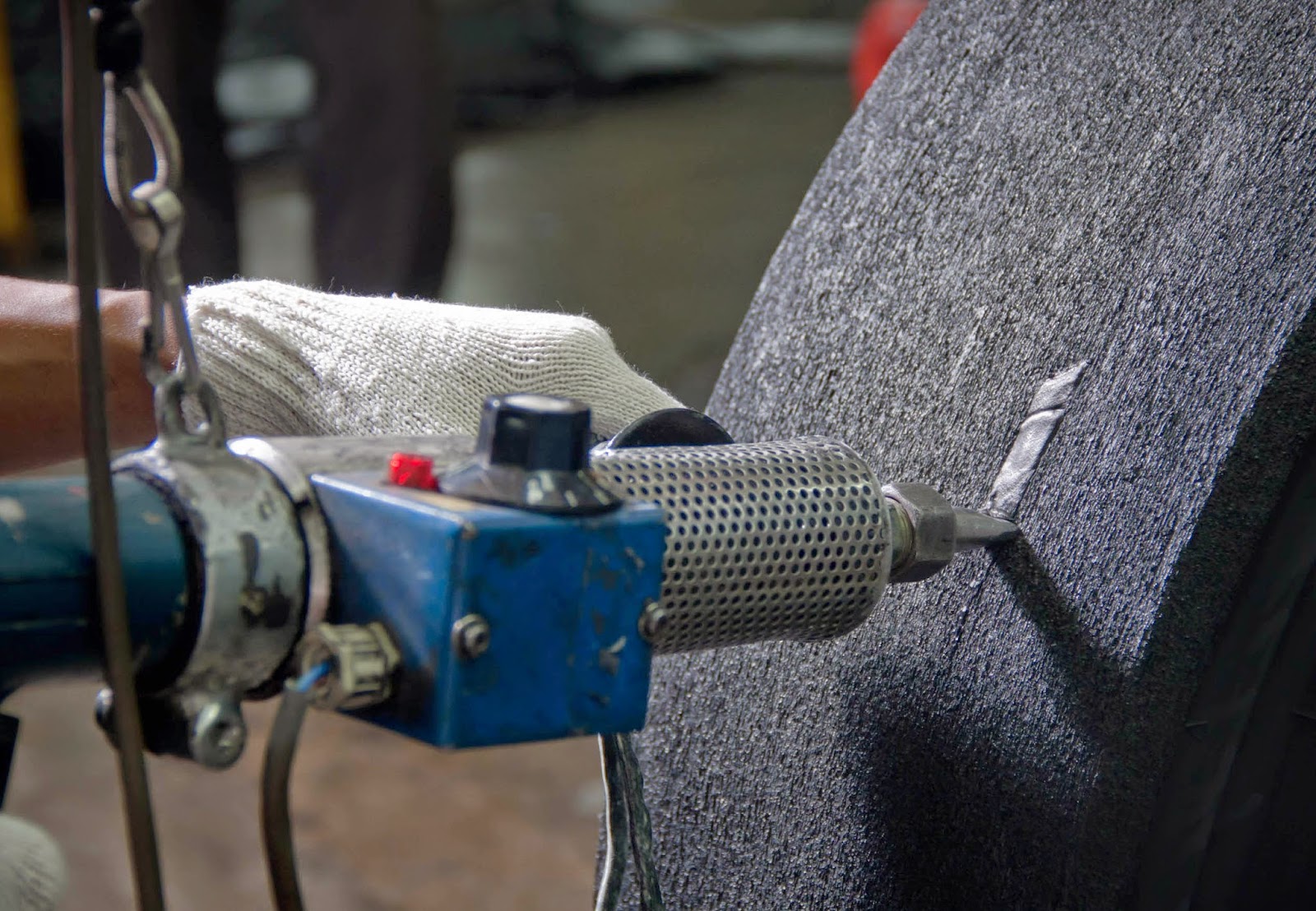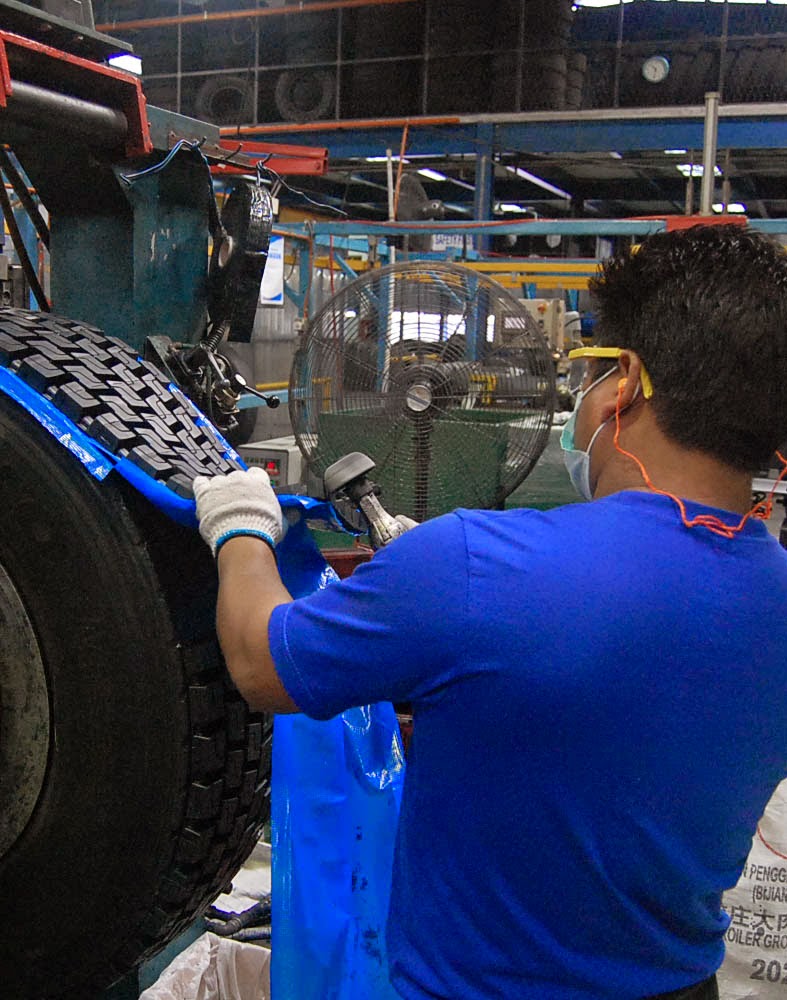Standard Operation Procedured ( SOP ) - Retreading Process-Quality Retreads Service
WHY RETREADING?
THE TYRE RETREADING PROCESS

STEP 1 : CASING SELECTION PROCESS
all casings collected are well covered under the shelter.
STEP 2 : INITIAL INSPECTION
STEP 3 : BUFFING PROCESS
STEP 4 : SKIVING PROCESS
STEP 5: REPAIRING PROCESS
STEP 6: CEMENTING PROCESS
STEP 7: FILLING PROCESS
STEP 10: CURIING PROCESS
WHY RETREADING?
Whether you are a motorist looking for ways to stretch the family budget or a fleet manager buying thousands of tyres for your company, costs must somehow be controlled in today's stringent economy. Truckers, airlines, construction companies, farmers and passenger car owners all purchase retreads for one basic reason: to save money.
In the manufacturing of a new tyre, a big portion of the cost is in the tyre casing. The tread, which is the area of the tyre which is in contact with the road, represents only a percentage of the new tyre cost. When a tyre has worn out and seems ready to be discarded, the bulk of its cost remains unrecovered! In fact, this tyre's useful life has not even began.
Advancements in technology and stringent standards have seen retreads become economically viable in every sense.
The many benefits of retreading:
The many benefits of retreading:
- 1.Cost 30% - 50% less than purchasing a new tyre
- 2.Environmentally friendly, reduce oil dependency and pollution from tyre disposal by 70% and 80% respectively.
- 3.A retreaded tyre is safe and durable as any comparable new tyre.
- 4.Retreaded tyres can be driven at same legal speeds as new tyres with no loss in safety, performance or comfort.
- 5.90% of the aircrafts worldwide retread their tyres including military aircraft such as the Hercules C-5A.
- 6.Saves North America 400 million gallons of oil each year.
- 7.Saves the USA trucking company US$2 Billion annually.
RETREADING INDUSTRY
Radialisation, improved quality, lack of understanding and consolidation are some of the issues the retreading industry has had to deal with the past 35 years. However, with the advancement of technology and economies of scale, retread manufacturing has reached a level of quality and sophistication unprecedented in its history, and today's retread plants are much larger than ever before.
Retreading, a business with an illustrious past, has an equally bright future. The casing of a radial truck tyre is now an investment, and the only way one gets a return is to retread it. Radialisation, which seriously undermined the passenger retreading market, was a boon to the truck tyre retreading market.
Retreaded truck tyres represent a savings of over $2 billion dollars annually for truckers and trucking companies in North America. Similarly for China, there lies a bright future for the China retreading industry. China Tyre Retreading and Recycling Association mentioned that the China government has reported that in 2004, China manufactured 239 million tyres and at the same time, produced 120 million worn tyres, a number that is expected to grow by 12% annually.
For most fleets, tyres represent the third largest item in their operation budget right after labour and fuel costs. The lowest possible cost-per-mile is achieved with a good tyre management programme that includes the use of quality retreads. Retreads are the replacement tyre of choice for truckers and fleets who purchase more than 18 million retreads annually in the United State and Canada.
Retreads are not only cost effective, but they are also dependable, reliable and safe. Retreads are used by truckers with scheduled delivery times, small package delivery companies with guaranteed delivery times, on commercial and military jets and by most school bus operators. Retreads are environmental friendly. Tyres are basically petrochemical products. It takes 22 gallons of oil to manufacture one new truck tire. Most of the oil is found in the casing, which is reused in the retreading process. As a result, it takes only 7 gallons of oil to produce a retread.
Retreaders, like trucking companies, have experienced considerable consolidation. Today, the most successful retreaders are those with the highest quality products, delivering the best possible return on investment to the fleets. Because of the competitive nature of the retreading industry, truckers can expect to see continuous improvement in quality, durability and reliability, as the major retread suppliers annually invest millions of dollars in research and development.
For most fleets, tyres represent the third largest item in their operation budget right after labour and fuel costs. The lowest possible cost-per-mile is achieved with a good tyre management programme that includes the use of quality retreads. Retreads are the replacement tyre of choice for truckers and fleets who purchase more than 18 million retreads annually in the United State and Canada.
Retreads are not only cost effective, but they are also dependable, reliable and safe. Retreads are used by truckers with scheduled delivery times, small package delivery companies with guaranteed delivery times, on commercial and military jets and by most school bus operators. Retreads are environmental friendly. Tyres are basically petrochemical products. It takes 22 gallons of oil to manufacture one new truck tire. Most of the oil is found in the casing, which is reused in the retreading process. As a result, it takes only 7 gallons of oil to produce a retread.
Retreaders, like trucking companies, have experienced considerable consolidation. Today, the most successful retreaders are those with the highest quality products, delivering the best possible return on investment to the fleets. Because of the competitive nature of the retreading industry, truckers can expect to see continuous improvement in quality, durability and reliability, as the major retread suppliers annually invest millions of dollars in research and development.
Back on earth, the future of retreading is dependent on the same principles that have enabled existing retreaders to remain in business. Constant attention to quality control, operating expenses, and equipment maintenance are at the core of every successful plant.
THE TYRE RETREADING PROCESS

STEP 1 : CASING SELECTION PROCESS
all casings collected are well covered under the shelter.
STEP 2 : INITIAL INSPECTION
- Each casing is thoroughly inspected by a well-trained technician
STEP 3 : BUFFING PROCESS
- Well-trained technician buffs and removes the worn tread from the casing to a specific radius and diameter.
STEP 4 : SKIVING PROCESS
- A skilled technician removes and embedded objects to ensure a clean and solid surface.
STEP 5: REPAIRING PROCESS
- To ensure all small holes and punctures are repaired to the International repair standard
STEP 6: CEMENTING PROCESS
- A thin layer of concreted rubber solution is sprayed onto the buffed surface.
STEP 7: FILLING PROCESS
- skived buzzouts are filled with gum cord
- A new precured tread is built on the tyre casing after a thin layer of cushion gum has been applied to the cemented surface.
STEP 9: ENVELOPING PROCESS
- A special envelope is used to enclose the tyre and during the process allowing the cushion gum and precured tread to successfully adhered together when vulcanization take place.
STEP 10: CURIING PROCESS
- All tyres are cured in the state-of-the-art curing chamber, to obtain permanent bonding of the precured tread to the casing.
STEP 11: FINAL INSPECTION PROCESS
- The tyre is now inspected before dispatch.



.jpg)






















